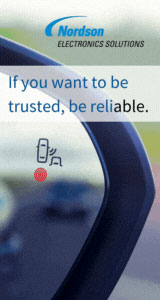| Sponsor |

|
Electronic Assembly Cleaning Basics
Monitoring & effectively controlling chemistry concentration when cleaning electronic assemblies is crucial for maintaining optimal cleanliness results & preventing costly consequences.
KYZEN
|
|
| Sponsor |

|
Reinforce Critical Components on PCBs
UV-curable, low-modulus ruggedizing adhesives secure BGAs/VGAs, improving shock & vibration resistance of electronic assemblies. Low-outgassing version available.
Dymax
|
|
| Ask the Experts |
|
|
March 9, 2011 - Updated
March 7, 2011 - Originally Posted
Solder Paste Volume for BGA Rework
When we rework BGA components we typically apply solder paste. Our BGA rework stencils match the aperture size and thickness as used on our production line. Therefore the solder volume added during BGA rework is equal to the solder volume used during production.
Since rework can never be as controlled or consistent as original assembly, should we use slightly more paste during BGA rework to compensate for irregularities in board flatness, pad condition etc.?
M. B.
|
| Expert Panel Responses |
It depends on the technique employed for the rework. If you are dispensing, or printing, so the volume constraints will change.
When rework takes place, the quality of the pad surface finish is key as highlighted. During reflow, the substrate pad material will dissolve partially into the bulk solder, so when rework takes place, the likelihood is that the surface material to bond onto will be more challenging - as it may be harder solution to solder onto.
This factor is key successful rework. Rework onto copper is easier than NiAu surface for example - as typically Au will dissolve fast in the original reflow, and for the rework, Ni will be the surface.
Another solution, instead of printing, or dispensing, is actually dipping the component into solder paste to ensure that the component has paste on all contact points prior to placement.
Board flatness - if there is warpage on the board, the significance will show up not only on paste replenishment, but on accuracy of component placement. Certainly the warpage shape will play a part in determining the solution, but minor on substrate side - it is more challenging if you are putting down the same component.
A smiley face warpage on the board will give challenge of bridging, and the sad face will give challenge of paste starvation. Target the worst case scenario - but if you can avoid the same component in the rework, that is best solution.
Doug Dixon
Marketing
360-Biz
Douglass Dixon is the Chief Marketing Officer for 360 BC Group, a marketing agency with offices throughout the US. 360 BC specializes in consulting and implementing successful marketing programs that utilize the latest in marketing, sales and technology strategies. As an electronics veteran, Dixon has worked in the industry for over 30 years for companies like Henkel, Universal Instruments, Camelot Systems, and Raytheon. Dixon's electronics industry experience includes a broad skill set that includes engineering, field service, applications, product management and marketing communications expertise.
|
|
Submit A Comment
|
Comments are reviewed prior to posting. You must include your full name to have your comments posted. We will not post your email address.
|
Free Newsletter Subscription
Circuitnet is built for professionals who bear the responsibility of looking ahead, imagining the future, and preparing for it.
Insert Your Email Address
|
| Sponsor |

|
Plasma as a Key Technology
Plasma technology improves electronics manufacturing, reduces oxide layers, prevents delamination & enables environmentally friendly products by using Openair-Plasma ® & PlasmaPlus®.
Plasmatreat GmbH
|
|
|





